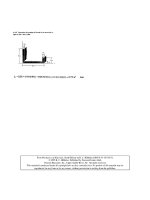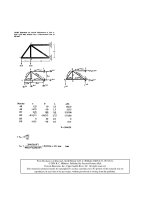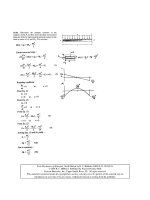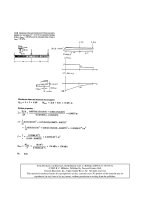Engineering Mechanics - Statics Episode 3 Part 1 doc
Bạn đang xem bản rút gọn của tài liệu. Xem và tải ngay bản đầy đủ của tài liệu tại đây (483.58 KB, 40 trang )
Engineering Mechanics - Statics Chapter 8
μ
pyg
pp
p
can be held.
Given:
θ
20 deg=
Solution:
Paper:
+
↑
Σ
F
y
= 0;
FF+ W− 0= F
W
2
=
F
μ
N= N
W
2
μ
=
Cylinder:
F' r
W
2
⎛
⎜
⎝
⎞
⎟
⎠
r− 0= F'
W
2
=
N'
W
2
⎛
⎜
⎝
⎞
⎟
⎠
sin
θ
()
−
W
2
μ
cos
θ
()
− 0= N'
W
2
sin
θ
()
1
μ
cos
θ
()
+
⎛
⎜
⎝
⎞
⎟
⎠
=
F'
μ
N'=
W
2
μ
W
2
⎛
⎜
⎝
⎞
⎟
⎠
sin
θ
()
1
μ
cos
θ
()
+
⎛
⎜
⎝
⎞
⎟
⎠
=
1
μ
sin
θ
()
cos
θ
()
+=
μ
1 cos
θ
()
−
sin
θ
()
=
μ
0.176=
Problem 8-43
The crate has a weight W
1
and a center of gravity at G. If the coefficient of static friction
between the crate and the floor is
μ
s
, determine if the man of weight W
2
can push the crate to
the left. The coefficient of static friction between his shoes and the floor is
μ
'
s
. Assume the
man exerts only a horizontal force on the crate.
801
© 2007 R. C. Hibbeler. Published by Pearson Education, Inc., Upper Saddle River, NJ. All rights reserved.
This material is protected under all copyright laws as they currently exist. No portion of this material may
be reproduced, in any form or by any means, without permission in writing from the publisher.
Engineering Mechanics - Statics Chapter 8
W
1
300 lb=
W
2
200 lb=
μ
s
0.2=
μ
'
s
0.35=
a 4.5 ft= c 3ft=
b 3.5 ft= d 4.5 ft=
Solution:
Σ
F
y
= 0;
N
C
W
1
− 0= N
C
W
1
=
Σ
F
x
= 0;
μ
s
N
C
P− 0= P
μ
s
N
C
=
Σ
Μ
O
= 0;
W
1
− xPd+ 0= x
Pd
W
1
=
Since
x 0.90 ft=
<
a 4.50 ft=
there will not be any tipping.
Σ
F
y
= 0;
N
m
W
2
− 0= N
m
W
2
= N
m
200.00 lb=
Σ
F
x
= 0;
PF
m
− 0= F
m
P= F
m
60.00 lb=
F
mmax
μ
'
s
N
m
= F
mmax
70.00 lb=
Since
F
m
60.00 lb=
<
F
mmax
70.00 lb=
then the
man can push the crate.
Problem 8-44
The crate has a weight W
1
and a center of gravity at G. If the coefficient of static friction
between the crate and the floor is
μ
s
, determine the smallest weight of the man so that he
can
push the crate to the left. The coefficient of static friction between his shoes and the floor is
μ
'
s
. Assume the man exerts only a horizontal force on the crate.
802
Given:
© 2007 R. C. Hibbeler. Published by Pearson Education, Inc., Upper Saddle River, NJ. All rights reserved.
This material is protected under all copyright laws as they currently exist. No portion of this material may
be reproduced, in any form or by any means, without permission in writing from the publisher.
Engineering Mechanics - Statics Chapter 8
W
1
300 lb=
W
2
200 lb=
μ
s
0.2=
μ
'
s
0.35=
a 4.5 ft= c 3ft=
b 3.5 ft= d 4.5 ft=
Solution:
Σ
F
y
= 0;
N
C
W
1
− 0= N
C
W
1
=
Σ
F
x
= 0;
μ
s
N
C
P− 0= P
μ
s
N
C
=
Σ
Μ
O
= 0;
W
1
− xPd+ 0= x
Pd
W
1
=
Since
x 0.90 ft=
<
a 4.50 ft=
there will not be any tipping.
Σ
F
x
= 0;
PF
m
− 0= F
m
P= F
m
60.00 lb=
F
m
μ
'
s
N
m
= N
m
F
m
μ
'
s
= N
m
171.4 lb=
Σ
F
y
= 0;
N
m
W
2
− 0= W
2
N
m
= W
2
171.4 lb=
Problem 8-45
The wheel has weight W
A
and rests on a surface for which the coefficient of friction is
μ
B
. A
cord wrapped around the wheel is attached to the top of the homogeneous block of weight W
C
.
803
Given:
© 2007 R. C. Hibbeler. Published by Pearson Education, Inc., Upper Saddle River, NJ. All rights reserved.
This material is protected under all copyright laws as they currently exist. No portion of this material may
be reproduced, in any form or by any means, without permission in writing from the publisher.
Engineering Mechanics - Statics Chapter 8
If the coefficient of static friction at D is
μ
D
determine the smallest vertical force that can be
applied tangentially to the wheel which will cause motion to impend.
Given:
W
A
20 lb=
μ
B
0.2=
W
C
30 lb=
μ
D
0.3=
h 3ft=
b 1.5 ft=
Solution: Assume that slipping occurs at B, but that the block does not move.
Guesses P 1lb= N
B
1lb= F
B
1lb= T 1lb= N
D
1lb= F
D
1lb=
x 1ft=
Given N
B
W
A
− P− 0= TF
B
− 0= PT− F
B
−
()
h
2
0=
F
B
μ
B
N
B
= T− F
D
+ 0= N
D
W
C
− 0=
Th N
D
x− 0=
P
N
B
F
B
T
N
D
F
D
x
⎛
⎜
⎜
⎜
⎜
⎜
⎜
⎜
⎜
⎜
⎝
⎞
⎟
⎟
⎟
⎟
⎟
⎟
⎟
⎟
⎟
⎠
Find PN
B
, F
B
, T, N
D
, F
D
, x,
()
=
P
N
B
F
B
T
N
D
F
D
⎛
⎜
⎜
⎜
⎜
⎜
⎜
⎜
⎝
⎞
⎟
⎟
⎟
⎟
⎟
⎟
⎟
⎠
13.33
33.33
6.67
6.67
30.00
6.67
⎛
⎜
⎜
⎜
⎜
⎜
⎜
⎜
⎝
⎞
⎟
⎟
⎟
⎟
⎟
⎟
⎟
⎠
lb= x 0.67 ft=
Now checke the assumptions
F
Dmax
μ
D
N
D
=
Since
F
D
6.67 lb=
<
F
Dmax
9.00 lb=
then the block does not slip
804
© 2007 R. C. Hibbeler. Published by Pearson Education, Inc., Upper Saddle River, NJ. All rights reserved.
This material is protected under all copyright laws as they currently exist. No portion of this material may
be reproduced, in any form or by any means, without permission in writing from the publisher.
Engineering Mechanics - Statics Chapter 8
Since
x 0.67 ft=
<
b
2
0.75 ft=
then the block does not tip.
So our original assumption is correct.
P 13.33 lb=
Problem 8-46
Determine the smallest couple moment which can be applied to the wheel of weight W
1
that will
cause impending motion. The cord is attached to the block of weight W
2
, and the coefficients of
static friction are
μ
B
and
μ
D
.
Given:
W
1
20 lb= a 1.5 ft=
W
2
30 lb= b 3ft=
μ
B
0.2= c 1.5 ft=
μ
D
0.3=
Solution:
For the wheel : Assume slipping occurs,
Σ
F
y
= 0;
N
B
W
1
− 0= N
B
W
1
= N
B
20.00 lb=
Σ
F
x
= 0;
T
μ
B
N
B
− 0= T
μ
B
N
B
= T 4.00 lb=
Σ
M
B
= 0;
MT2a− 0= MT2a= M 12.00 lb ft⋅=
For block
Σ
F
y
= 0;
N
D
W
2
− 0= N
D
W
2
= N
D
30.00 lb=
Σ
F
x
= 0;
F
D
T− 0= F
D
T= F
D
4.00 lb=
Σ
M
O
= 0;
Tb N
D
x− 0= xT
b
N
D
= x 0.40 ft=
F
Dmax
μ
D
N
D
= F
Dmax
9.00 lb=
Since
F
D
4.00 lb=
<
F
Dmax
9.00 lb=
then the block doesn't slip
805
© 2007 R. C. Hibbeler. Published by Pearson Education, Inc., Upper Saddle River, NJ. All rights reserved.
This material is protected under all copyright laws as they currently exist. No portion of this material may
be reproduced, in any form or by any means, without permission in writing from the publisher.
Engineering Mechanics - Statics Chapter 8
Since
x 0.40 ft=
<
c
2
0.75 ft=
then the block doesn't tip.
Thus neither slipping nor tipping occurs for the block, and our assumption and answer are
correct.
Problem 8-47
The beam AB has a negligible mass and thickness and is subjected to a triangular distributed loading.
It is supported at one end by a pin and at the other end by a post having a mass m
p
and negligible
thickness. Determine the minimum force
P
needed to move the post. The coefficients of static
friction at B and C are
μ
B
and
μ
C
respectively.
Given:
m
p
50 kg= a 2m=
μ
B
0.4= b 400 mm=
μ
C
0.2= c 300 mm=
w 800
N
m
= d 3=
g 9.81
m
s
2
= e 4=
Solution:
Member AB:
Σ
M
A
= 0;
1
2
wa
⎛
⎜
⎝
⎞
⎟
⎠
−
2a
3
⎛
⎜
⎝
⎞
⎟
⎠
N
B
a+ 0= N
B
1
3
wa= N
B
533.33 N=
806
© 2007 R. C. Hibbeler. Published by Pearson Education, Inc., Upper Saddle River, NJ. All rights reserved.
This material is protected under all copyright laws as they currently exist. No portion of this material may
be reproduced, in any form or by any means, without permission in writing from the publisher.
Engineering Mechanics - Statics Chapter 8
Post:
Assume slipping occurs at C:
F
C
μ
C
N
C
=
The initial guesses are
P 1N= N
C
1N= F
B
1N=
Given
e−
d
2
e
2
+
Pc F
B
bc+()+ 0=
e
d
2
e
2
+
PF
B
−
μ
C
N
C
− 0=
d
e
2
d
2
+
PN
C
+ N
B
− m
p
g− 0=
P
N
C
F
B
⎛
⎜
⎜
⎜
⎝
⎞
⎟
⎟
⎟
⎠
Find PN
C
, F
B
,
()
= P 354.79 N=
Now check to see if the post slips at B.
F
Bmax
μ
B
N
B
=
Since
F
B
122 N=
<
F
Bmax
213 N=
then our assumptions are correct
P 355 N=
Problem 8-48
The beam AB has a negligible mass and thickness and is subjected to a triangular distributed loading.
It is supported at one end by a pin and at the other end by a post having a mass m
p
and negligible
thickness. Determine the two coefficients of static friction at B and at C so that when the
magnitude of the applied force is increased to
P
the post slips at both B and C simultaneously.
807
© 2007 R. C. Hibbeler. Published by Pearson Education, Inc., Upper Saddle River, NJ. All rights reserved.
This material is protected under all copyright laws as they currently exist. No portion of this material may
be reproduced, in any form or by any means, without permission in writing from the publisher.
Engineering Mechanics - Statics Chapter 8
Given:
m
p
50 kg=
P 150 N=
w 800
N
m
=
a 2m=
b 400 mm=
c 300 mm=
d 3=
e 4=
Solution: Member AB:
1
2
− wa
2a
3
N
B
a+ 0=
N
B
1
3
wa= N
B
533.33 N=
Post:
Guesses N
C
1N=
μ
B
0.2=
μ
C
0.2=
Given
N
C
N
B
− P
d
d
2
e
2
+
⎛
⎜
⎝
⎞
⎟
⎠
+ m
p
g− 0=
e
d
2
e
2
+
⎛
⎜
⎝
⎞
⎟
⎠
P
μ
C
N
C
−
μ
B
N
B
− 0=
e−
d
2
e
2
+
⎛
⎜
⎝
⎞
⎟
⎠
Pc
μ
B
N
B
bc+()+ 0=
N
C
μ
B
μ
C
⎛
⎜
⎜
⎜
⎝
⎞
⎟
⎟
⎟
⎠
Find N
C
μ
B
,
μ
C
,
()
=
μ
B
μ
C
⎛
⎜
⎝
⎞
⎟
⎠
0.0964
0.0734
⎛
⎜
⎝
⎞
⎟
⎠
=
808
© 2007 R. C. Hibbeler. Published by Pearson Education, Inc., Upper Saddle River, NJ. All rights reserved.
This material is protected under all copyright laws as they currently exist. No portion of this material may
be reproduced, in any form or by any means, without permission in writing from the publisher.
Engineering Mechanics - Statics Chapter 8
Problem 8-49
The block of weight W is being pulled up the inclined plane of slope
α
using a force
P
. If
P
acts at
the angle
φ
as shown, show that for slipping to occur, P = W sin(
α
+
θ
)/ cos(
φ
−
θ
) where
θ
is the
angle of friction;
θ
= tan
-1
μ
Solution: Let
μ
tan
θ
()
=
Σ
F
x
= 0;
P cos
φ
()
W sin
α
()
−
μ
N− 0=
Σ
F
y
= 0;
NWcos
α
()
− P sin
φ
()
+ 0=
P cos
φ
()
W sin
α
()
−
μ
W cos
α
()
P sin
φ
()
− 0=
(
−
PW
sin
α
()
μ
cos
α
()
+
cos
φ
()
μ
sin
φ
()
+
⎛
⎜
⎝
⎞
⎟
⎠
= W
sin
α
()
tan
θ
()
cos
α
()
+
cos
φ
()
tan
θ
()
sin
φ
()
+
⎛
⎜
⎝
⎞
⎟
⎠
=
PW
sin
α
()
cos
θ
()
sin
θ
()
cos
α
()
+
cos
φ
()
cos
θ
()
sin
θ
()
sin
φ
()
+
⎛
⎜
⎝
⎞
⎟
⎠
=
PW
sin
αθ
+
()
cos
φθ
−
()
⎛
⎜
⎝
⎞
⎟
⎠
= QED()
Problem 8-50
Determine the angle
φ
at which
P
should act on the block so that the magnitude of
P
is as small as
possible to begin pulling the block up the incline. What is the corresponding value of P? The block
has weight W and the slope
α
is known.
809
© 2007 R. C. Hibbeler. Published by Pearson Education, Inc., Upper Saddle River, NJ. All rights reserved.
This material is protected under all copyright laws as they currently exist. No portion of this material may
be reproduced, in any form or by any means, without permission in writing from the publisher.
Engineering Mechanics - Statics Chapter 8
Solution: Let
μ
tan
θ
()
=
Σ
F
x
= 0;
P cos
φ
()
W sin
α
()
−
μ
N− 0=
Σ
F
y
= 0;
NWcos
α
()
− P sin
φ
()
+ 0=
P cos
φ
()
W sin
α
()
−
μ
W cos
α
()
P sin
φ
()
− 0=
(
−
PW
sin
α
()
μ
cos
α
()
+
cos
φ
()
μ
sin
φ
()
+
⎛
⎜
⎝
⎞
⎟
⎠
= W
sin
α
()
tan
θ
()
cos
α
()
+
cos
φ
()
tan
θ
()
sin
φ
()
+
⎛
⎜
⎝
⎞
⎟
⎠
=
PW
sin
α
()
cos
θ
()
sin
θ
()
cos
α
()
+
cos
φ
()
cos
θ
()
sin
θ
()
sin
φ
()
+
⎛
⎜
⎝
⎞
⎟
⎠
= W
sin
αθ
+
()
cos
φθ
−
()
=
dP
d
φ
W
sin
αθ
+
()
sin
φθ
−
()
cos
2
φθ
−
()
⎡
⎢
⎣
⎤
⎥
⎦
= 0=
sin
αθ
+
()
sin
φθ
−
()
0=
sin
φθ
−
()
0=
φθ
= PWsin
αφ
+
()
=
Problem 8-51
Two blocks A and B, each having a mass M, are connected by the linkage shown. If the
coefficient of static friction at the contacting surfaces is
μ
s
determine the largest vertical force
P
that may be applied to pin C of the linkage without causing the blocks to move. Neglect the
weight of the links.
810
© 2007 R. C. Hibbeler. Published by Pearson Education, Inc., Upper Saddle River, NJ. All rights reserved.
This material is protected under all copyright laws as they currently exist. No portion of this material may
be reproduced, in any form or by any means, without permission in writing from the publisher.
Engineering Mechanics - Statics Chapter 8
M 6kg=
μ
s
0.5=
θ
1
30 deg=
θ
2
30 deg=
Solution:
Guesses N
A
1N= F
A
1N= F
AC
1N=
P 1N= N
B
1N= F
B
1N= F
BC
1N=
Assume that A slips first
Given
F
AC
cos
θ
2
()
F
BC
− 0=
F
AC
sin
θ
2
()
P− 0=
N
A
Mg− F
AC
sin
θ
2
()
− 0=
F
A
F
AC
cos
θ
2
()
− 0=
F
BC
cos
θ
1
()
Mgsin
θ
1
()
− F
B
− 0=
F
BC
− sin
θ
1
()
Mgcos
θ
1
()
− N
B
+ 0=
F
A
μ
s
N
A
=
P
1
N
A
F
A
N
B
F
B
F
AC
F
BC
⎛
⎜
⎜
⎜
⎜
⎜
⎜
⎜
⎜
⎜
⎝
⎞
⎟
⎟
⎟
⎟
⎟
⎟
⎟
⎟
⎟
⎠
Find PN
A
, F
A
, N
B
, F
B
, F
AC
, F
BC
,
()
= P
1
23.9 N=
Assume that B slips first
811
Given:
© 2007 R. C. Hibbeler. Published by Pearson Education, Inc., Upper Saddle River, NJ. All rights reserved.
This material is protected under all copyright laws as they currently exist. No portion of this material may
be reproduced, in any form or by any means, without permission in writing from the publisher.
Engineering Mechanics - Statics Chapter 8
Given
F
AC
cos
θ
2
()
F
BC
− 0=
F
AC
sin
θ
2
()
P− 0=
N
A
Mg− F
AC
sin
θ
2
()
− 0=
F
A
F
AC
cos
θ
2
()
− 0=
F
BC
cos
θ
1
()
Mgsin
θ
1
()
− F
B
− 0=
F
BC
− sin
θ
1
()
Mgcos
θ
1
()
− N
B
+ 0=
F
B
μ
s
N
B
=
P
2
N
A
F
A
N
B
F
B
F
AC
F
BC
⎛
⎜
⎜
⎜
⎜
⎜
⎜
⎜
⎜
⎜
⎝
⎞
⎟
⎟
⎟
⎟
⎟
⎟
⎟
⎟
⎟
⎠
Find PN
A
, F
A
, N
B
, F
B
, F
AC
, F
BC
,
()
= P
2
51.5 N=
P min P
1
P
2
,
()
= P 23.9 N=
Problem 8-52
Block C has a mass m
c
and is confined between two walls by smooth rollers. If the block rests on top
of the spool of mass m
s
, determine the minimum cable force
P
needed to move the spool. The cable is
wrapped around the spool's inner core. The coefficients of static friction at
μ
A
and
μ
B
.
Given:
g 9.81
m
s
2
=
m
c
50 kg=
m
s
40 kg=
μ
A
0.3=
812
© 2007 R. C. Hibbeler. Published by Pearson Education, Inc., Upper Saddle River, NJ. All rights reserved.
This material is protected under all copyright laws as they currently exist. No portion of this material may
be reproduced, in any form or by any means, without permission in writing from the publisher.
Engineering Mechanics - Statics Chapter 8
μ
B
0.6= r
1
0.2 m= r
2
0.4 m=
Solution: Assume that the spool slips at A but not at B.
The initial guesses are
F
B
2N= P 3N= N
B
1N=
Given PF
B
−
μ
A
m
c
g− 0=
N
B
m
s
g− m
c
g− 0=
Pr
1
r
2
+
()
F
B
2r
2
− 0=
F
B
P
N
B
⎛
⎜
⎜
⎜
⎝
⎞
⎟
⎟
⎟
⎠
Find F
B
P, N
B
,
()
=
F
B
P
N
B
⎛
⎜
⎜
⎜
⎝
⎞
⎟
⎟
⎟
⎠
441.45
588.60
882.90
⎛
⎜
⎜
⎝
⎞
⎟
⎟
⎠
N=
Now check the no slip assumption at B
F
Bmax
μ
B
N
B
= F
Bmax
529.74 N=
Since
F
B
441 N=
<
F
Bmax
530 N=
then our assumptions are correct.
P 589 N=
Problem 8-53
A board of weight W
1
is placed across the channel and a boy of weight W
2
attempts to walk
across. If the coefficient of static friction at A and B
μ
s
, determine if he can make the crossing;
and if not, how far will he get from A before the board slips?
813
© 2007 R. C. Hibbeler. Published by Pearson Education, Inc., Upper Saddle River, NJ. All rights reserved.
This material is protected under all copyright laws as they currently exist. No portion of this material may
be reproduced, in any form or by any means, without permission in writing from the publisher.
Engineering Mechanics - Statics Chapter 8
Given:
W
1
50 lb=
W
2
100 lb=
μ
s
0.4=
a 10 ft=
b 4=
c 3=
Solution:
Initial guesses:
N
A
10 lb= N
B
20 lb= d 3ft=
Given
Σ
F
x
= 0;
μ
s
N
A
μ
s
N
B
b
b
2
c
2
+
⎛
⎜
⎝
⎞
⎟
⎠
+ N
B
c
b
2
c
2
+
⎛
⎜
⎝
⎞
⎟
⎠
− 0=
Σ
F
y
= 0;
N
A
W
2
− W
1
− N
B
b
b
2
c
2
+
⎛
⎜
⎝
⎞
⎟
⎠
+
μ
s
N
B
c
b
2
c
2
+
⎛
⎜
⎝
⎞
⎟
⎠
+ 0=
Σ
M
B
= 0;
W
1
a
2
⎛
⎜
⎝
⎞
⎟
⎠
W
2
ad−()+ N
A
a− 0=
N
A
N
B
d
⎛
⎜
⎜
⎜
⎝
⎞
⎟
⎟
⎟
⎠
Find N
A
N
B
, d,
()
=
N
A
N
B
⎛
⎜
⎝
⎞
⎟
⎠
60.34
86.21
⎛
⎜
⎝
⎞
⎟
⎠
lb= d 6.47 ft=
Since
d 6.47 ft=
<
a 10.00 ft=
then the board will slip
Problem 8-54
Determine the minimum force P needed to push the tube E up the incline. The tube has a
mass of M
1
and the roller D has a mass of M
2
. The force acts parallel to the plane, and the
coefficients of static friction at the contacting surfaces are
μ
A
,
μ
B
and
μ
C
. Each cylinder has a
radius of r.
814
© 2007 R. C. Hibbeler. Published by Pearson Education, Inc., Upper Saddle River, NJ. All rights reserved.
This material is protected under all copyright laws as they currently exist. No portion of this material may
be reproduced, in any form or by any means, without permission in writing from the publisher.
Engineering Mechanics - Statics Chapter 8
Given:
M
1
75 kg=
M
2
100 kg=
μ
A
0.3=
μ
B
0.25=
μ
C
0.4=
θ
30 deg=
r 150 mm=
g 9.81
m
s
2
=
Solution:
Initial guesses:
N
A
100 N= F
A
10 N= P 100 N=
N
B
200 N= F
B
20 N=
N
C
300 N= F
C
30 N=
Given
For roller D
Σ
F
x'
= 0;
PN
A
− F
C
− M
2
gsin
θ
()
− 0=
Σ
F
y'
= 0;
N
C
F
A
+ M
2
gcos
θ
()
− 0=
Σ
M
0'
= 0;
F
A
rF
C
r− 0=
For tube E
Σ
F
x'
= 0;
N
A
F
B
− M
1
gsin
θ
()
− 0=
Σ
F
y'
= 0;
N
B
F
A
− M
1
gcos
θ
()
− 0=
Σ
M
0'
= 0;
F
A
rF
B
r− 0=
Assuming slipping occurs only at A.
F
A
μ
A
N
A
=
815
© 2007 R. C. Hibbeler. Published by Pearson Education, Inc., Upper Saddle River, NJ. All rights reserved.
This material is protected under all copyright laws as they currently exist. No portion of this material may
be reproduced, in any form or by any means, without permission in writing from the publisher.
Engineering Mechanics - Statics Chapter 8
N
A
N
B
N
C
F
A
F
B
F
C
P
⎛
⎜
⎜
⎜
⎜
⎜
⎜
⎜
⎜
⎜
⎝
⎞
⎟
⎟
⎟
⎟
⎟
⎟
⎟
⎟
⎟
⎠
Find N
A
N
B
, N
C
, F
A
, F
B
, F
C
, P,
()
=
N
A
N
B
N
C
F
A
F
B
F
C
P
⎛
⎜
⎜
⎜
⎜
⎜
⎜
⎜
⎜
⎜
⎝
⎞
⎟
⎟
⎟
⎟
⎟
⎟
⎟
⎟
⎟
⎠
526
795
692
158
158
158
1174
⎛
⎜
⎜
⎜
⎜
⎜
⎜
⎜
⎜
⎝
⎞
⎟
⎟
⎟
⎟
⎟
⎟
⎟
⎟
⎠
N=
F
Bmax
μ
B
N
B
= F
Cmax
μ
C
N
C
=
F
Bmax
F
Cmax
⎛
⎜
⎝
⎞
⎟
⎠
199
277
⎛
⎜
⎝
⎞
⎟
⎠
N=
Since
F
B
158 N=
<
F
Bmax
199 N=
and
F
C
158 N=
<
F
Cmax
277 N=
then our
assumption is correct
P 1174 N=
Problem 8-55
The concrete pipe at A rests on top of B and C. If the coefficient of static friction between the
pipes is
μ
s
and at the ground
μ
'
s
, determine their smallest values so that the pipes will not slip.
Each pipe has a radius r and weight W, and the angle between the centers as indicated is
θ
.
816
© 2007 R. C. Hibbeler. Published by Pearson Education, Inc., Upper Saddle River, NJ. All rights reserved.
This material is protected under all copyright laws as they currently exist. No portion of this material may
be reproduced, in any form or by any means, without permission in writing from the publisher.
Engineering Mechanics - Statics Chapter 8
Total System :
Σ
F
y
= 0;
2N' 3W− 0= N'
3
2
W=
Pipe C:
Σ
F
x
= 0;
F− cos
θ
()
Nsin
θ
()
+ F'− 0=
Σ
F
y
= 0;
N' W− Ncos
θ
()
− F sin
θ
()
− 0=
Σ
M
O
= 0;
F r F' r− 0=
Solving,
FF'=
1
2
W sin
θ
()
cos
θ
()
1+
⎛
⎜
⎝
⎞
⎟
⎠
= N
W
2
=
For Pipe A:
μ
s
N
1
2
W sin
θ
()
cos
θ
()
1+
⎛
⎜
⎝
⎞
⎟
⎠
≥
μ
s
sin
θ
()
cos
θ
()
1+
≥
For Pipe C:
μ
'
s
N'
1
2
W sin
θ
()
cos
θ
()
1+
⎛
⎜
⎝
⎞
⎟
⎠
≥
μ
'
s
1
3
sin
θ
()
cos
θ
()
1+
≥
Problem 8-56
The uniform pole has a weight W and length L. Its end
B is tied to a supporting cord, and end A is placed
against the wall, for which the coefficient of static
friction is
μ
s
. Determine the largest angle
θ
at which
the pole can be placed without slipping.
Solution:
Σ
F
x
= 0;
N
A
Tsin
θ
2
⎛
⎜
⎝
⎞
⎟
⎠
− 0=
Σ
F
y
= 0;
μ
s
N
A
W− Tcos
θ
2
⎛
⎜
⎝
⎞
⎟
⎠
+ 0=
Σ
M
B
= 0;
N
A
− L cos
θ
()
μ
s
N
A
Lsin
θ
()
− W
L
2
⎛
⎜
⎝
⎞
⎟
⎠
sin
θ
()
+ 0=
817
Solution:
© 2007 R. C. Hibbeler. Published by Pearson Education, Inc., Upper Saddle River, NJ. All rights reserved.
This material is protected under all copyright laws as they currently exist. No portion of this material may
be reproduced, in any form or by any means, without permission in writing from the publisher.
Engineering Mechanics - Statics Chapter 8
Solving we find
N
A
Tsin
θ
2
⎛
⎜
⎝
⎞
⎟
⎠
=
μ
s
Tsin
θ
2
⎛
⎜
⎝
⎞
⎟
⎠
W− Tcos
θ
2
⎛
⎜
⎝
⎞
⎟
⎠
+ 0= WTcos
θ
2
⎛
⎜
⎝
⎞
⎟
⎠
μ
s
sin
θ
2
⎛
⎜
⎝
⎞
⎟
⎠
+
⎛
⎜
⎝
⎞
⎟
⎠
=
Tsin
θ
2
⎛
⎜
⎝
⎞
⎟
⎠
Lcos
θ
()
μ
s
Lsin
θ
()
+
()
T cos
θ
2
⎛
⎜
⎝
⎞
⎟
⎠
μ
s
sin
θ
2
⎛
⎜
⎝
⎞
⎟
⎠
+
⎛
⎜
⎝
⎞
⎟
⎠
L
2
sin
θ
()
=
sin
θ
2
⎛
⎜
⎝
⎞
⎟
⎠
cos
θ
()
μ
s
sin
θ
()
+
()
1
2
sin
θ
()
cos
θ
2
⎛
⎜
⎝
⎞
⎟
⎠
μ
s
sin
θ
2
⎛
⎜
⎝
⎞
⎟
⎠
+
⎛
⎜
⎝
⎞
⎟
⎠
=
μ
s
2
sin
θ
2
⎛
⎜
⎝
⎞
⎟
⎠
sin
θ
()
1
2
sin
θ
()
cos
θ
2
⎛
⎜
⎝
⎞
⎟
⎠
sin
θ
2
⎛
⎜
⎝
⎞
⎟
⎠
cos
θ
()
−=
μ
s
sin
θ
()
cos
θ
2
⎛
⎜
⎝
⎞
⎟
⎠
2sin
θ
2
⎛
⎜
⎝
⎞
⎟
⎠
cos
θ
()
−
sin
θ
2
⎛
⎜
⎝
⎞
⎟
⎠
sin
θ
()
=
μ
s
cos
θ
2
⎛
⎜
⎝
⎞
⎟
⎠
sin
θ
2
⎛
⎜
⎝
⎞
⎟
⎠
2 cos
θ
2
⎛
⎜
⎝
⎞
⎟
⎠
2
sin
θ
2
⎛
⎜
⎝
⎞
⎟
⎠
2
−
⎛
⎜
⎝
⎞
⎟
⎠
2sin
θ
2
⎛
⎜
⎝
⎞
⎟
⎠
cos
θ
2
⎛
⎜
⎝
⎞
⎟
⎠
−= cot
θ
2
⎛
⎜
⎝
⎞
⎟
⎠
cos
θ
2
⎛
⎜
⎝
⎞
⎟
⎠
− tan
θ
2
⎛
⎜
⎝
⎞
⎟
⎠
+=
μ
s
tan
θ
2
⎛
⎜
⎝
⎞
⎟
⎠
=
θ
2atan
μ
()
=
Problem 8-57
The carpenter slowly pushes the uniform board horizontally over the top of the saw horse. The
board has a uniform weight density
γ
and the saw horse has a weight W and a center of gravity
at G. Determine if the saw horse will stay in position, slip, or tip if the board is pushed forward
at the given distance d. The coefficients of static friction are shown in the figure.
Given:
γ
3
lb
ft
=
818
© 2007 R. C. Hibbeler. Published by Pearson Education, Inc., Upper Saddle River, NJ. All rights reserved.
This material is protected under all copyright laws as they currently exist. No portion of this material may
be reproduced, in any form or by any means, without permission in writing from the publisher.
Engineering Mechanics - Statics Chapter 8
L 18 ft=
W 15 lb=
a 3ft=
b 1ft=
μ
0.5=
μ
' 0.3=
d 10 ft=
Solution:
Board:
L−
γ
L
2
⎛
⎜
⎝
⎞
⎟
⎠
Nd+ 0= N
1
2
L
2
γ
d
⎛
⎜
⎝
⎞
⎟
⎠
= N 48.60 lb=
To cause slipping of the board on the saw horse:
P
xb
μ
N= P
xb
24.30 lb=
To cause slipping at the ground:
P
xg
μ
'N W+()= P
xg
19.08 lb=
To cause tipping
NW+()bP
xt
a− 0=
P
xt
NW+()b
a
= P
xt
21.20 lb=
Choose the critical case
P
x
min P
xb
P
xg
, P
xt
,
()
= P
x
19.08 lb=
Problem 8-58
The carpenter slowly pushes the uniform board horizontally over the top of the saw horse. The
board has a uniform weight density
γ
and the saw horse has a weight W and a center of gravity
at G. Determine if the saw horse will stay in position, slip, or tip if the board is pushed forward
at the given distance d. The coefficients of static friction are shown in the figure.
Given:
γ
3
lb
ft
=
819
© 2007 R. C. Hibbeler. Published by Pearson Education, Inc., Upper Saddle River, NJ. All rights reserved.
This material is protected under all copyright laws as they currently exist. No portion of this material may
be reproduced, in any form or by any means, without permission in writing from the publisher.
Engineering Mechanics - Statics Chapter 8
L 18 ft=
W 15 lb=
a 3ft=
b 1ft=
μ
0.5=
μ
' 0.3=
d 14 ft=
Solution:
Board:
L−
γ
L
2
⎛
⎜
⎝
⎞
⎟
⎠
Nd+ 0= N
1
2
L
2
γ
d
⎛
⎜
⎝
⎞
⎟
⎠
= N 34.71 lb=
To cause slipping of the board on the saw horse:
P
xb
μ
N= P
xb
17.36 lb=
To cause slipping at the ground:
P
xg
μ
'N W+()= P
xg
14.91 lb=
To cause tipping
NW+()bP
xt
a− 0=
P
xt
NW+()b
a
= P
xt
16.57 lb=
Choose the critical case
P
x
min P
xb
P
xg
, P
xt
,
()
= P
x
14.91 lb=
Problem 8-59
The disk of mass m
o
rests on the surface for which the coefficient of static friction is
μ
A
Determine the largest couple moment M that can be applied to the bar without causing motion.
820
© 2007 R. C. Hibbeler. Published by Pearson Education, Inc., Upper Saddle River, NJ. All rights reserved.
This material is protected under all copyright laws as they currently exist. No portion of this material may
be reproduced, in any form or by any means, without permission in writing from the publisher.
Engineering Mechanics - Statics Chapter 8
Given:
m
o
45 kg=
μ
A
0.2=
a 300 mm=
b 400 mm=
r 125 mm=
Solution:
Guesses
M 1Nm= N
A
1N=
B
x
1N= B
y
1N=
Given
MB
x
b− B
y
a− 0=
B
x
μ
A
N
A
− 0=
N
A
m
o
g− B
y
− 0=
B
y
r
μ
A
N
A
r− 0=
M
N
A
B
x
B
y
⎛
⎜
⎜
⎜
⎜
⎝
⎞
⎟
⎟
⎟
⎟
⎠
Find MN
A
, B
x
, B
y
,
()
=
N
A
B
x
B
y
⎛
⎜
⎜
⎜
⎝
⎞
⎟
⎟
⎟
⎠
551.81
110.36
110.36
⎛
⎜
⎜
⎝
⎞
⎟
⎟
⎠
N= M 77.3 N m⋅=
Problem 8-60
The disk of mass m
0
rests on the surface for which the coefficient of static friction is
μ
A
Determine the friction force at A.
821
© 2007 R. C. Hibbeler. Published by Pearson Education, Inc., Upper Saddle River, NJ. All rights reserved.
This material is protected under all copyright laws as they currently exist. No portion of this material may
be reproduced, in any form or by any means, without permission in writing from the publisher.
Engineering Mechanics - Statics Chapter 8
Given:
M 50 N m⋅=
m
o
45 kg=
μ
A
0.2=
a 300 mm=
b 400 mm=
r 125 mm=
Solution: Assume no motion
Guesses
B
x
1N= B
y
1N= N
A
1N= F
A
1N=
Given MB
y
a− B
x
b− 0=
N
A
B
y
− m
o
g− 0=
B
x
F
A
− 0=
B
y
rF
A
r− 0=
B
x
B
y
N
A
F
A
⎛
⎜
⎜
⎜
⎜
⎝
⎞
⎟
⎟
⎟
⎟
⎠
Find B
x
B
y
, N
A
, F
A
,
()
=
N
A
F
A
⎛
⎜
⎝
⎞
⎟
⎠
512.88
71.43
⎛
⎜
⎝
⎞
⎟
⎠
N=
Check assumption:
F
Amax
μ
A
N
A
=
Since
F
A
71.4 N=
<
F
Amax
102.6 N=
then our assumption is good.
F
A
71.4 N=
Problem 8-61
A block of weight W is attached to a light rod AD that pivots at pin A. If the coefficient of static
friction between the plane and the block is
μ
s
, determine the minimum angle
θ
at which the
b
lock ma
y
be
p
laced on the
p
lane without sli
pp
in
g
. Ne
g
lect the
s
ize of the block in the
822
© 2007 R. C. Hibbeler. Published by Pearson Education, Inc., Upper Saddle River, NJ. All rights reserved.
This material is protected under all copyright laws as they currently exist. No portion of this material may
be reproduced, in any form or by any means, without permission in writing from the publisher.
Engineering Mechanics - Statics Chapter 8
calculation.
Given:
a 4ft=
b 2ft=
c 3ft=
μ
s
0.4=
W 6lb=
Solution:
Establish a unit vector
perpendicular to the plane.
r
BC
b−
c
0
⎛
⎜
⎜
⎝
⎞
⎟
⎟
⎠
= r
BA
b−
0
a
⎛
⎜
⎜
⎝
⎞
⎟
⎟
⎠
=
n
1
r
BC
r
BA
×
r
BC
r
BA
×
= n
1
0.77
0.51
0.38
⎛
⎜
⎜
⎝
⎞
⎟
⎟
⎠
=
Establish 2 other unit vectors in this plane, and one in the z direction
k
0
0
1
⎛
⎜
⎜
⎝
⎞
⎟
⎟
⎠
= r
CA
0
c−
a
⎛
⎜
⎜
⎝
⎞
⎟
⎟
⎠
= n
2
r
CA
r
CA
= n
3
n
1
n
2
×=
Guess T 1lb= N 1lb=
θ
10 deg=
Given Nn
1
T cos
θ
()
n
2
sin
θ
()
n
3
−
()
+
μ
s
N sin
θ
()
n
2
cos
θ
()
n
3
+
()
− Wk− 0=
N
T
θ
⎛
⎜
⎜
⎝
⎞
⎟
⎟
⎠
Find NT,
θ
,
()
=
N
T
⎛
⎜
⎝
⎞
⎟
⎠
2.30
5.46
⎛
⎜
⎝
⎞
⎟
⎠
lb=
θ
20.37 deg=
Problem 8-62
Determine the force
P
needed to lift the load of wei
g
ht W. Smooth rollers are
p
laced between
823
© 2007 R. C. Hibbeler. Published by Pearson Education, Inc., Upper Saddle River, NJ. All rights reserved.
This material is protected under all copyright laws as they currently exist. No portion of this material may
be reproduced, in any form or by any means, without permission in writing from the publisher.
Engineering Mechanics - Statics Chapter 8
g
p
the wedges. The coefficient of static friction between A and C and between B and D is
μ
s
.
Neglect the weight of each wedge.
Given:
θ
10 deg=
W 100 lb=
μ
s
0.3=
Solution:
Initial guesses:
N' 10 lb= N
A
15 lb=
N
B
20 lb= P 5lb=
Given
Wedge B:
Σ
F
x
= 0;
N' sin
θ
()
N
B
− 0=
Σ
F
y
= 0;
N' cos
θ
()
W−
μ
s
N
B
− 0=
Wedge A:
Σ
F
x
= 0;
PN'sin
θ
()
−
μ
s
N
A
− 0=
Σ
F
y
= 0;
N
A
N' cos
θ
()
− 0=
N'
N
B
N
A
P
⎛
⎜
⎜
⎜
⎜
⎝
⎞
⎟
⎟
⎟
⎟
⎠
Find N' N
B
, N
A
, P,
()
=
N'
N
B
N
A
⎛
⎜
⎜
⎜
⎝
⎞
⎟
⎟
⎟
⎠
107.2
18.6
105.6
⎛
⎜
⎜
⎝
⎞
⎟
⎟
⎠
lb=
P 50.3 lb=
Problem 8-63
The wedge is used to level the floor of a building. For the floor loading shown, determine the
horizontal force
P
that must be applied to move the wedge forward. The coefficient of static
friction between the wedge and the two surfaces of contact is
μ
s
. Neglect the size and weight
824
© 2007 R. C. Hibbeler. Published by Pearson Education, Inc., Upper Saddle River, NJ. All rights reserved.
This material is protected under all copyright laws as they currently exist. No portion of this material may
be reproduced, in any form or by any means, without permission in writing from the publisher.
Engineering Mechanics - Statics Chapter 8
of the wedge and the thickness of the beam.
Units Used:
kN 10
3
N=
Given:
F
1
2kN= a 3m=
F
2
4kN= b 2m=
F
3
4kN= c 3m=
F
4
2kN=
θ
15 deg=
μ
s
0.25=
Solution:
Guesses
N
1
1kN= N
2
1kN= P 1kN=
Given
F
1
N
1
−
()
ab+ c+()F
2
bc+()+ F
3
c+ 0=
N
2
cos
θ
()
μ
s
N
2
sin
θ
()
− N
1
− 0=
μ
s
N
1
μ
s
N
2
cos
θ
()
+ N
2
sin
θ
()
+ P− 0=
N
1
N
2
P
⎛
⎜
⎜
⎜
⎝
⎞
⎟
⎟
⎟
⎠
Find N
1
N
2
, P,
()
=
N
1
N
2
⎛
⎜
⎝
⎞
⎟
⎠
6
6.66
⎛
⎜
⎝
⎞
⎟
⎠
kN=
P 4.83 kN=
Problem 8-64
The three stone blocks have weights W
A
, W
B,
and W
C
. Determine the smallest horizontal force
P
that must be applied to block C in order to move this block.The coefficient of static friction
between the blocks is
μ
s,
and between the floor and each block
μ
'
s.
825
© 2007 R. C. Hibbeler. Published by Pearson Education, Inc., Upper Saddle River, NJ. All rights reserved.
This material is protected under all copyright laws as they currently exist. No portion of this material may
be reproduced, in any form or by any means, without permission in writing from the publisher.









